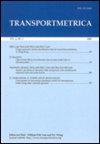RECENT ADVANCES IN TRAVEL CHOICE BEHAVIOR MODELING
引用次数: 2
Abstract
This special issue “Travel Choice Behavior Modeling” is organized based on selected papers presented at the International Association of Travel Behavior Research (IATBR) in Kyoto, Japan, 2006. Great strides have been made recently in travel choice behavior modeling (Bovy and Fiorenzo-Catalano, 2007; Beale and Bonsall, 2007; Chorus et al., 2007; Han et al., 2007; Kim et al., 2007; Tsirimpa et al., 2007). New approaches have been developed to augment and improve existing ones or to seek new modeling paradigms (Bonsall, 2004; Senbil and Kitamura, 2004; Jou et al., 2008; Arentze and Timmermans, 2007). It is timely to take inventory of what we have so far and provide a preview of what lies ahead. Travel involves choices of destination, departure time, mode, and route. Typically, travelers face a large set of alternatives, often with imperfect information about them. How to generate reasonable alternatives and therefore avoid burdening the modeling effort with unnecessary ones; how to develop and include new explanatory variables beyond the traditional socio-economic ones, such as the influence of travel information, marketing, etc; how to take advantages of revealed preference (RP) and stated preference (SP) surveys to improve the accuracy of travel choice models; and how to consider correlated choices in the presence of taste heterogeneity, etc are just some examples of recent advancements. This special issue is aimed to cover some recent methodological advances in travel choice behavior modeling. Five papers are collected in this special issue, as summarized below. Defining the choice sets appropriately is important for analyzing choice behavior, estimating parameters of choice models, or predicting choice probabilities. This, however, is not a simple task. The paper by Van Nes, Hoogendoorn-Lanser and Koppelman investigates the relationship between the type of choice set and the purpose of the analysis, for estimation or prediction. The authors differentiate choice sets as being “objective” (generated) or “subjective” (observed). The study concludes that for estimation purposes, observed subjective choice sets are preferable; on the other hand, generated objective choice sets appear to be most suitable for prediction purposes. The paper by Sakano and Benjamin incorporates both RP and SP data in the structural equations model to analyze activity-based travel behavior. The model is then applied to examine the relationship between activities and mode choice for the Puget Sound Regional Council in Seattle, USA. The study finds that the attitude toward comfort of travel, car requirement for job, and travel time are significant predictors for the mode choice decision. The authors conclude that the RP-SP model can help improve the fit of the model over the RP-alone model and that the model developed can be extended to the analysis of more complex decision-making processes involving more detailed information on modes, activities, and times. Despite substantial recent efforts in improving route choice models, few of them are integrated into traffic assignment studies. The paper by Bekhor, Toledo, and Prashker出行选择行为模型研究进展
本期特刊“旅行选择行为模型”是根据2006年在日本京都举行的国际旅行行为研究协会(IATBR)上发表的论文整理而成。最近在旅行选择行为建模方面取得了巨大的进步(Bovy和Fiorenzo-Catalano, 2007;Beale and Bonsall, 2007;Chorus等人,2007;Han et al., 2007;Kim et al., 2007;Tsirimpa et al., 2007)。已经开发出新的方法来增强和改进现有的方法或寻求新的建模范式(Bonsall, 2004;Senbil and Kitamura, 2004;Jou et al., 2008;Arentze and Timmermans, 2007)。现在是时候盘点一下我们目前所拥有的,并提供一个未来的预览。旅行包括目的地、出发时间、方式和路线的选择。通常情况下,旅行者面临着大量的选择,而这些选择的信息往往是不完善的。如何生成合理的备选方案,从而避免不必要的备选方案给建模工作增加负担;如何在传统的社会经济变量(如旅游信息、市场营销等的影响)之外开发和纳入新的解释变量;如何利用显示偏好(RP)和陈述偏好(SP)调查来提高旅游选择模型的准确性;以及如何在口味异质性存在的情况下考虑相关选择,等等,这些都是最近的一些进展。本期特刊旨在介绍最近在旅行选择行为建模方面的一些方法进展。本期特刊收录了五篇论文,总结如下。适当地定义选择集对于分析选择行为、估计选择模型的参数或预测选择概率非常重要。然而,这不是一项简单的任务。Van Nes, Hoogendoorn-Lanser和Koppelman的论文研究了选择集的类型与分析目的(用于估计或预测)之间的关系。作者将选择集区分为“客观”(生成)和“主观”(观察)。研究得出结论:为了估计的目的,观察到的主观选择集更可取;另一方面,生成的目标选择集似乎最适合于预测目的。Sakano和Benjamin的论文将RP和SP数据结合到结构方程模型中来分析基于活动的出行行为。然后将该模型应用于美国西雅图普吉特海湾地区委员会的活动与模式选择之间的关系。研究发现,出行舒适性态度、工作用车需求、出行时间是出行方式选择决策的显著预测因子。作者得出结论,RP-SP模型可以帮助提高模型的拟合性,并且所开发的模型可以扩展到分析更复杂的决策过程,包括更详细的模式,活动和时间信息。尽管最近在改进路线选择模型方面做出了大量努力,但很少将其纳入交通分配研究。Bekhor, Toledo和Prashker的论文
本文章由计算机程序翻译,如有差异,请以英文原文为准。
求助全文
约1分钟内获得全文
求助全文

 求助内容:
求助内容: 应助结果提醒方式:
应助结果提醒方式:


